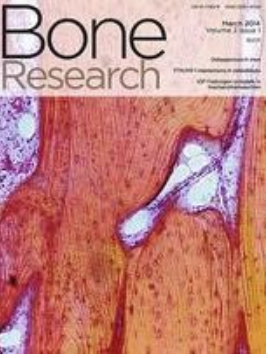Pak4-mediated crosstalk between necroptotic macrophages and tendon stem/progenitor cells contributes to traumatic heterotopic ossification formation.
IF 15
1区 医学
Q1 CELL & TISSUE ENGINEERING
引用次数: 0
Abstract
The formation of traumatic heterotopic ossification (HO) is an abnormal repair process after soft tissue injury. Recent studies establish the involvement of immune cells and cellular metabolism in the tissue healing process; however, their role in HO remains unknown. Here, by using murine burn/tenotomy model in vivo and tendon stem/progenitor cells (TSPCs) osteogenic differentiation model in vitro, together with techniques including transgenic knockout, gene knockdown, transcriptome and proteome sequencings, mass spectrometry, co-immunoprecipitation, seahorse, etc., we reveal a novel p21-activated kinase 4 (Pak4) mediated crosstalk where the necroptotic macrophages arouse TSPCs with reduced fatty acid β-oxidation (FAO), to promote aberrant osteogenic differentiation during HO formation. Necroptosis blockade with Mlkl knockout (C57BL/6JGpt-Mlklem1Cd1679/Gpt) significantly reduces HO than WT mice. Extracellular vesicle (EVs) secreted from necroptotic bone marrow-derived macrophages (BMDMs, NecroMφ-EVs) are determined to motivate FAO reduction in TSPCs and result in higher osteogenic activity. Pak4 conditional knockout (C57BL/6JGpt-Pak4em1Cflox/Gpt) in macrophage significantly increases FAO and reduces HO than Flox mice, as well as local injection of PAK4-/--EVs (NecroMφ-EVs with Pak4 knockout) than NecroMφ-EVs, and the protective effects are reversed after transfection of Fabp3S122D, a phosphomimetic mutant of S122 on fatty acid binding protein 3 (Fabp3) phosphorylation site. Mechanically, after soft tissue injury, macrophages infiltrate, and necroptosis occurs, accompanied by paracrine EVs-derived Pak4, which binds directly to Fabp3 and phosphorylates it at the S122 site in TSPCs, results in reduced FAO, finally osteogenic behavior, and HO formation. This study adds perceptiveness into abnormal regeneration-based theory for traumatic HO and raises treatment strategy development.pak4介导的坏死巨噬细胞和肌腱干/祖细胞之间的串扰有助于创伤性异位骨化的形成。
外伤性异位骨化(HO)的形成是软组织损伤后的异常修复过程。最近的研究证实免疫细胞和细胞代谢参与组织愈合过程;然而,它们在HO中的作用尚不清楚。本文通过小鼠体内烧伤/肌腱切断模型和体外肌腱干/祖细胞(TSPCs)成骨分化模型,结合转基因敲除、基因敲除、转录组和蛋白质组测序、质谱、共免疫沉淀、海马等技术,揭示了一种新的p21活化激酶4 (Pak4)介导的串音,其中坏死巨噬细胞通过减少脂肪酸β-氧化(FAO)激发TSPCs。在HO形成过程中促进异常成骨分化。与WT小鼠相比,Mlkl敲除(C57BL/6JGpt-Mlklem1Cd1679/Gpt)阻断坏死下垂可显著降低HO。由坏死的骨髓源性巨噬细胞(bmdm, NecroMφ-EVs)分泌的细胞外囊泡(EVs)被确定可以促进FAO减少TSPCs并导致更高的成骨活性。巨噬细胞中Pak4条件敲除(C57BL/6JGpt-Pak4em1Cflox/Gpt)显著高于Flox小鼠,局部注射Pak4 -/- EVs(敲除Pak4的NecroMφ-EVs)显著高于NecroMφ-EVs,在脂肪酸结合蛋白3 (Fabp3)磷酸化位点上S122的拟磷突变体Fabp3S122D转染后,保护作用逆转。机械上,软组织损伤后,巨噬细胞浸润,坏死下垂发生,伴有旁分泌ev衍生的Pak4,它直接与Fabp3结合,并在TSPCs的S122位点磷酸化Fabp3,导致FAO减少,最终形成成骨行为和HO形成。本研究为创伤性HO的异常再生理论提供了新的认识,并提出了治疗策略的发展。
本文章由计算机程序翻译,如有差异,请以英文原文为准。
求助全文
约1分钟内获得全文
求助全文
来源期刊

Bone Research
CELL & TISSUE ENGINEERING-
CiteScore
20.00
自引率
4.70%
发文量
289
审稿时长
20 weeks
期刊介绍:
Established in 2013, Bone Research is a newly-founded English-language periodical that centers on the basic and clinical facets of bone biology, pathophysiology, and regeneration. It is dedicated to championing key findings emerging from both basic investigations and clinical research concerning bone-related topics. The journal's objective is to globally disseminate research in bone-related physiology, pathology, diseases, and treatment, contributing to the advancement of knowledge in this field.
 求助内容:
求助内容: 应助结果提醒方式:
应助结果提醒方式:


